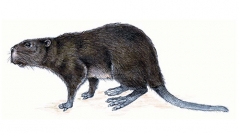

 Geodiversitas
30 (4) - Pages 765-778
Geodiversitas
30 (4) - Pages 765-778The fossil record of the family Castoridae in Poland is rather poor. It consists mainly of small Miocene species, Chalicomys jaegeri Kaup, 1832, Steneofiber eseri (Meyer, 1846), and S. minutus Meyer, 1838, as well as Pliocene Boreofiber wenzensis (Sulimski, 1964) and more abundant remains of Castor fiber Linnaeus, 1758, from the late Pleistocene. Herein, the first discovery of Trogontherium cuvieri Fischer de Waldheim, 1809, a large Eurasian beaver from the early middle Pleistocene site of Kozi Grzbiet (Central Poland) is reported. This species was widespread in Eurasia during the late Pliocene and early Pleistocene, when it reached its maximum dispersal, ranging from France eastwards to China and from northern Siberia (the Kolyma region) southwards to the Sea of Azov. It became extinct in the middle Pleistocene (Saalian). The taxonomic history and complex nomenclature of this beaver are reviewed and discussed. The European fossil record of this species and some evolutionary trends in its dentition are summarized. Also, a brief review of the postcranial characters and possible mode of life of the animal are presented. In general, its adaptations confirm a more terrestrial lifestyle than that of the modern Castor.
Mammalia, Rodentia, Castoridae, adaptations, distribution, systematics, Kozi Grzbiet, Pleistocene